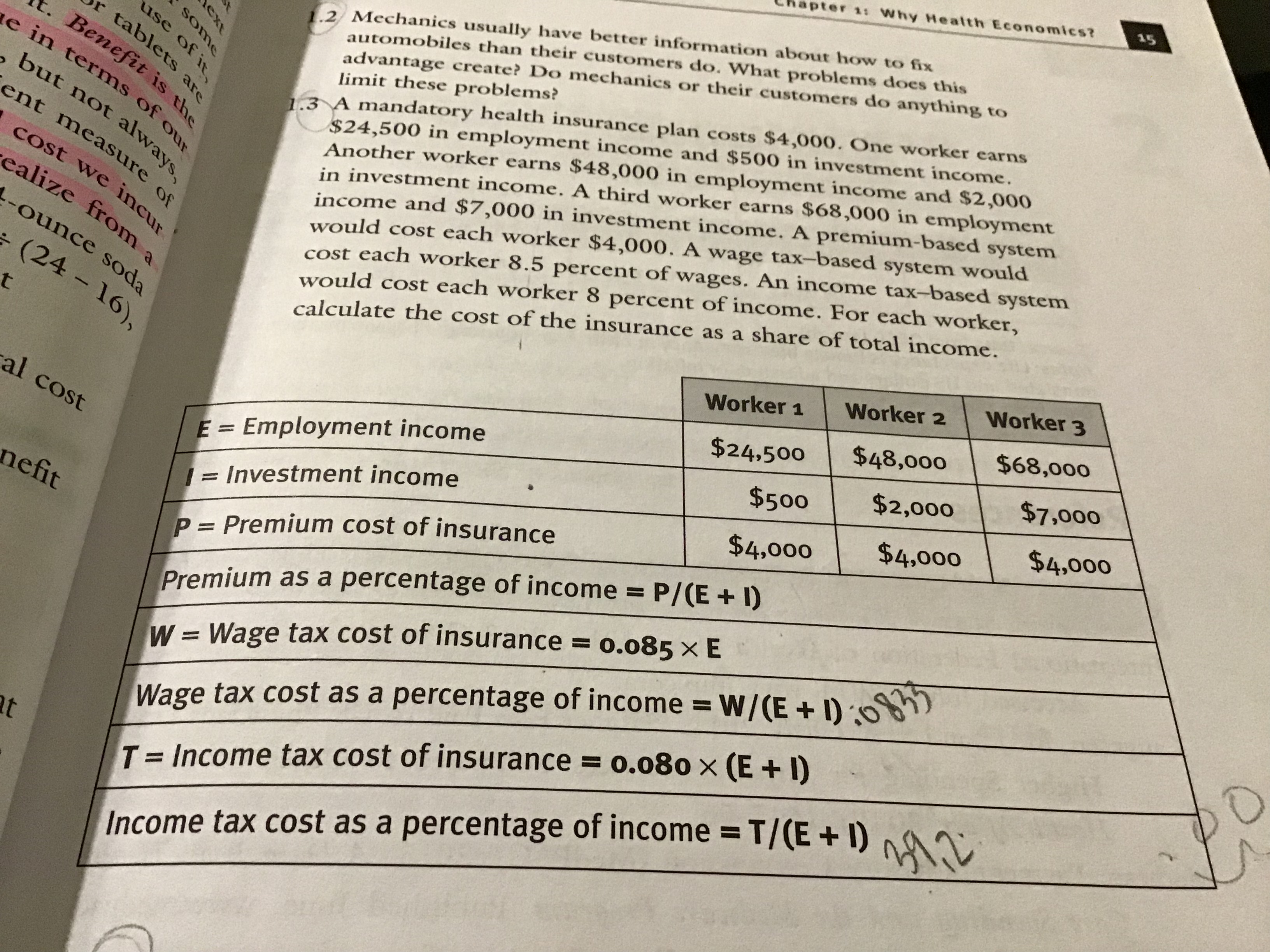
Principles of Economics 2e
2nd Edition
ISBN: 9781947172364
Author: Steven A. Greenlaw; David Shapiro
Publisher: OpenStax
expand_more
expand_more
format_list_bulleted
Question
A mandatory health insurance plan costs $4,000. One worker earns $24,000 in employment income and $500 in investment income. Another worker earns $48,000 in employment income and $2,000 in investment income. A third worker earns $68,000 in employment income and $7,000 in investment income. A premium-based system would cost each worker $4,000. A wage tax-based system would cost each worker 8.5 percent of wages. An income tax-based system would cost each worker 8 percent of income. For each worker, calculate the cost of the insurance as a share of total income.

Transcribed Image Text:CRapter 1s Why Health Economics?
2 Mechanics usually have better information about how to fix
automobiles than their customers do. What problems does this
advantage create? Do mechanics or their customers do anything to
limit these problems?
3 A mandatory health insurance plan costs $4,000. One worker earns
$24,500 in employment income and $500 in investment income
Another worker earns $48,000 in employment income and $2,00o
in investment income. A third worker earns $68,000 in employment
income and $7,000 in investment income. A premium-based system
would cost each worker $4,000. A wage tax-based system would
cost each worker 8.5 percent of wages. An income tax-based system
would cost each worker 8 percent of income. For each worker,
calculate the cost of the insurance as a share of total income
6)
Worker 1Worker 2 Worker 3
$24,500 $48,000$68,000
$500 $2,00o $7,000
$4,000 $4,000 $4,000
= Employment income
ef
Investment income
- Premium cost of insurance
Premium as a percentage of income P/(E +ID
W = Wage tax cost of insurance-0.085 × E
Wage tax cost as a percentage of income W/CE+D
7-income tax cost of insurance-0.080 × (E + 1)
Income tax cost as a percentage of incomeTE
Expert Solution
This question has been solved!
Explore an expertly crafted, step-by-step solution for a thorough understanding of key concepts.
This is a popular solution
Trending nowThis is a popular solution!
Step by stepSolved in 6 steps

Knowledge Booster
Learn more about
Need a deep-dive on the concept behind this application? Look no further. Learn more about this topic, economics and related others by exploring similar questions and additional content below.Similar questions
- How can deductibles, copayments, and coinsurance reduce moral hazard?arrow_forwardWhat is an actuarially fair insurance policy?arrow_forwardIn an insurance system, would you expect each person to receive in benefits pretty much what they pay in premiums or is it just that the average benefits paid will equal the average premiums paid?arrow_forward
- Exercise B7 What is an income effect?arrow_forwardUsing two demand and supply diagrams, one for the low-wage labor market and one for the high-wage labor market, explain how information technology can increase income inequality if it is a complement to high-income workers like salespeople and managers, but a substitute for low-come workers like file clerks and telephone receptionists.arrow_forwardEdna is living in a retirement home where home where most of her needs are taken care of, but she has some discretionary spending. Based on the basket of goods in Table 22.5, by what percentage does Ednas cost of living increase between time 1 and time 2arrow_forward
- A website offers a place for people to buy and sell emeralds, but information about emeralds can be quite imperfect. The website then enacts a rule that all sellers in the market must pay for two independent examinations of their emerald, which are available to the customer for inspection. How would you expect this improved information to affect demand for emeralds on this website? How would you expect this improved information to affect the quantity of high-quality emeralds sold on the website?arrow_forwardTo what sorts of customers would an insurance company offer a policy with a high copay? What about a high premium with a lower copay?arrow_forwardHow can moral hazard lead to more costly insurance premiums than one was expected?arrow_forward
arrow_back_ios
SEE MORE QUESTIONS
arrow_forward_ios
Recommended textbooks for you
 Principles of Economics 2eEconomicsISBN:9781947172364Author:Steven A. Greenlaw; David ShapiroPublisher:OpenStax
Principles of Economics 2eEconomicsISBN:9781947172364Author:Steven A. Greenlaw; David ShapiroPublisher:OpenStax Microeconomics: Private and Public Choice (MindTa...EconomicsISBN:9781305506893Author:James D. Gwartney, Richard L. Stroup, Russell S. Sobel, David A. MacphersonPublisher:Cengage Learning
Microeconomics: Private and Public Choice (MindTa...EconomicsISBN:9781305506893Author:James D. Gwartney, Richard L. Stroup, Russell S. Sobel, David A. MacphersonPublisher:Cengage Learning Economics: Private and Public Choice (MindTap Cou...EconomicsISBN:9781305506725Author:James D. Gwartney, Richard L. Stroup, Russell S. Sobel, David A. MacphersonPublisher:Cengage Learning
Economics: Private and Public Choice (MindTap Cou...EconomicsISBN:9781305506725Author:James D. Gwartney, Richard L. Stroup, Russell S. Sobel, David A. MacphersonPublisher:Cengage Learning
 Exploring EconomicsEconomicsISBN:9781544336329Author:Robert L. SextonPublisher:SAGE Publications, Inc
Exploring EconomicsEconomicsISBN:9781544336329Author:Robert L. SextonPublisher:SAGE Publications, Inc Principles of MicroeconomicsEconomicsISBN:9781305156050Author:N. Gregory MankiwPublisher:Cengage Learning
Principles of MicroeconomicsEconomicsISBN:9781305156050Author:N. Gregory MankiwPublisher:Cengage Learning

Principles of Economics 2e
Economics
ISBN:9781947172364
Author:Steven A. Greenlaw; David Shapiro
Publisher:OpenStax

Microeconomics: Private and Public Choice (MindTa...
Economics
ISBN:9781305506893
Author:James D. Gwartney, Richard L. Stroup, Russell S. Sobel, David A. Macpherson
Publisher:Cengage Learning

Economics: Private and Public Choice (MindTap Cou...
Economics
ISBN:9781305506725
Author:James D. Gwartney, Richard L. Stroup, Russell S. Sobel, David A. Macpherson
Publisher:Cengage Learning


Exploring Economics
Economics
ISBN:9781544336329
Author:Robert L. Sexton
Publisher:SAGE Publications, Inc

Principles of Microeconomics
Economics
ISBN:9781305156050
Author:N. Gregory Mankiw
Publisher:Cengage Learning